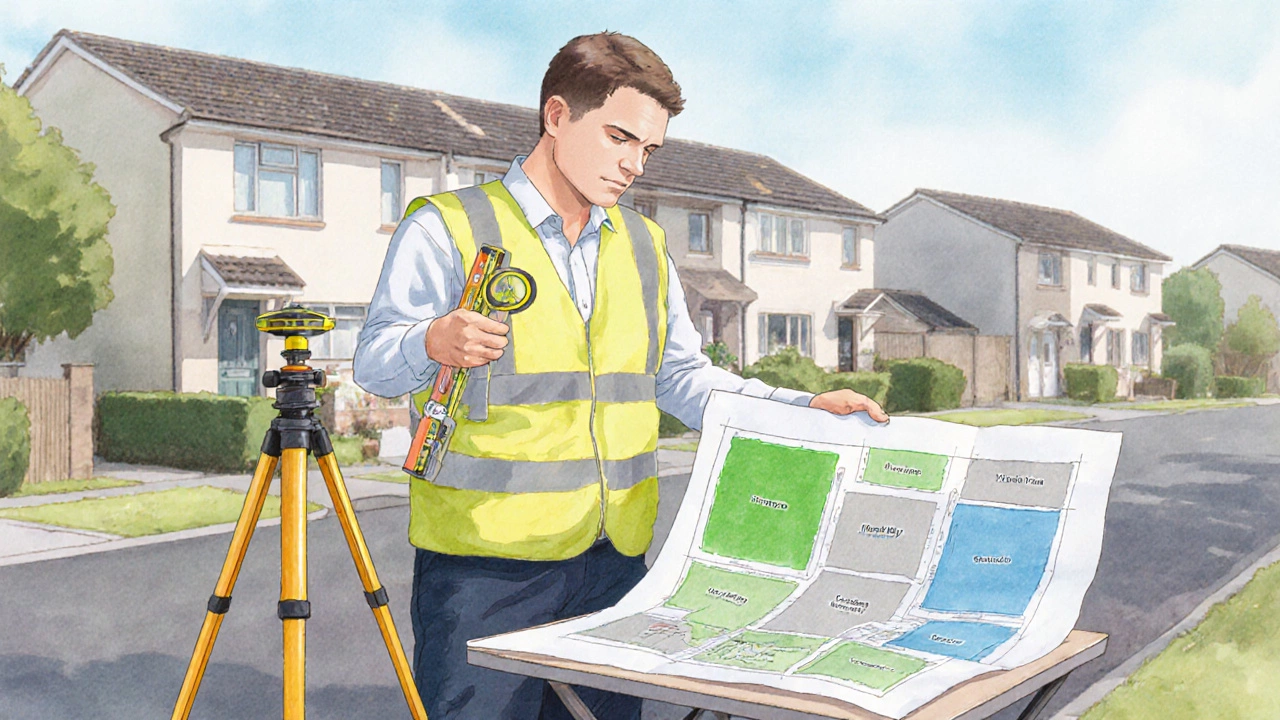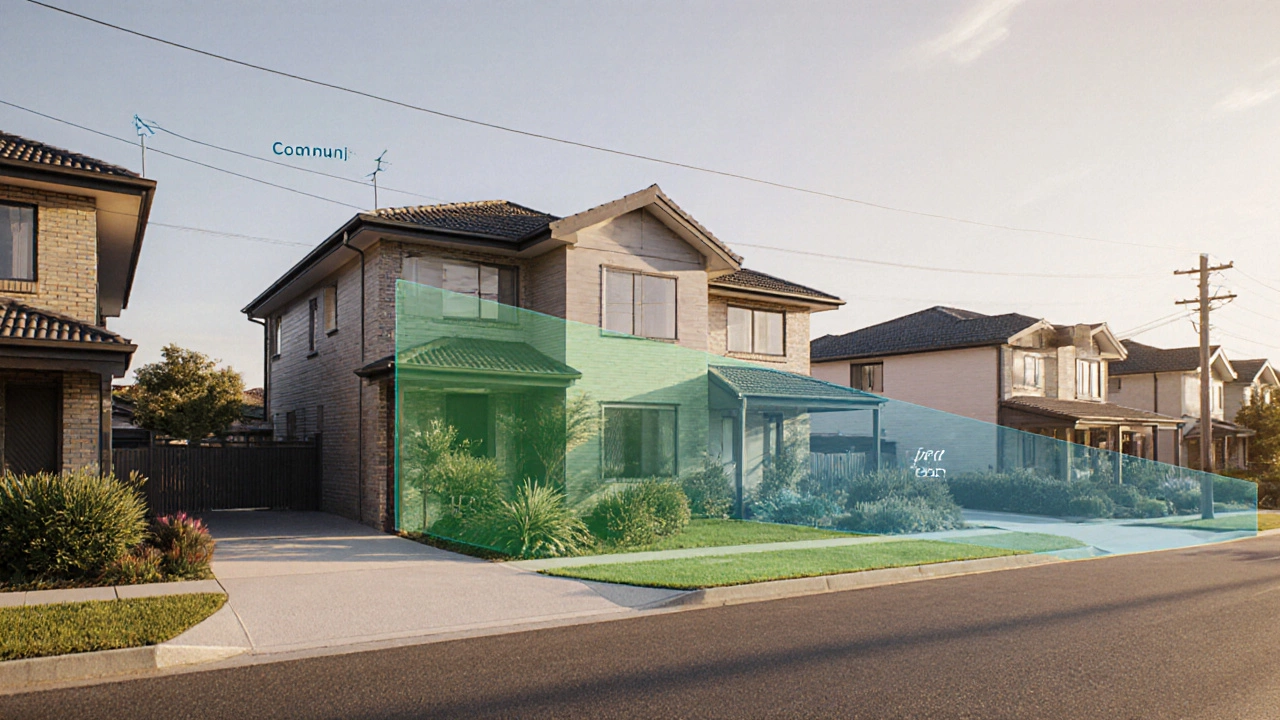Townhouse Land Ownership Checker
Ownership Details
Private Lot
Your exclusive ownership. Can be sold separately.
Common Property
Shared with all owners. Maintained by owner’s corp.
Stated Area
Partially owned, partially shared. Requires approval for changes.
Key Takeaways
- Most townhouses sit on a mix of private titled land and common property managed by an owner’s corporation.
- A title search and the strata plan are the quickest ways to confirm ownership.
- Maintenance responsibilities and council fees differ depending on whether the land is private, common or a stated area.
- Disputes often arise from unclear boundaries or easements; a professional survey can clear them up.
- Converting common property to private ownership is rare but possible with council and owner‑corp approval.
TL;DR
If you own a townhouse, the strip of land around it is usually split between your own titled lot, the building’s common property, and a “stated area” that you share with neighbours. The easiest way to know who owns what is to pull the title deed, read the strata plan, and, if needed, get a qualified survey. Understanding the split tells you who pays for maintenance, who can sell the land, and what rights you have.
How to Find Out Who Owns the Land Around Your Townhouse
Townhouse is a low‑rise, attached dwelling that typically shares walls with neighbours. The land that sits immediately outside the front and rear fences is often the subject of confusion. To untangle it, follow these steps:
- Locate your title deed. In Victoria you can order it from the Land Use Victoria portal. The deed lists the exact parcel of land registered to you.
- Obtain the building’s strata plan. This plan shows the division between private lots, common property, and any stated areas.
- Check the owner’s corporation minutes for any resolutions that alter land use (e.g., adding a driveway extension).
- If the documents are unclear, hire a licensed surveyor to conduct a boundary survey. The survey report will colour‑code each portion of land.
- Consult a property solicitor to interpret any easements or restrictive covenants that may affect ownership.
Once you have these records, you’ll know exactly which parts are yours, which belong to the owner’s corporation, and which are shared “stated areas.”

Types of Land Associated with Townhouses
In most Australian strata schemes three categories appear on the plan:
| Ownership Type | Who Holds Title | Maintenance Responsibility | Can Be Sold Separately |
|---|---|---|---|
| Private Lot | Individual owner (you) | Owner only (e.g., garden, driveway if within your lot) | Yes |
| Common Property | Owner’s corporation (collectively) | Owner’s corporation - funded by levies | No (unless re‑subdivision approved) |
| Stated Area | Individual owner, but recorded in strata plan | Owner - but levied like common property for shared services | Usually Yes, but may be subject to scheme rules |
The townhouse land ownership question often boils down to whether the strip you’re looking at is a private lot, a stated area, or part of the common property.
Legal Implications of Different Ownership Types
Understanding the label matters because each type brings its own rights and obligations:
- Private Lot: You can fence, landscape, or even sell the land without needing owner‑corp approval. However, any structural change that affects the building’s integrity still requires council consent.
- Common Property: The owner’s corporation decides what gets done (e.g., paving the front footpath). You pay levies based on the unit entitlement, and you cannot unilaterally alter the area.
- Stated Area: It sits somewhere between private and common. You own it, but the owner‑corp may levy maintenance fees because the area serves a communal purpose (e.g., a shared driveway). Selling a stated area usually needs a vote at a general meeting.
Failure to recognise these differences can lead to costly disputes. For example, a neighbour who fences off a claimed “stated area” without council approval may be forced to remove it and pay compensation.
Common Pitfalls and How to Avoid Them
Even seasoned owners run into trouble. Here are the most frequent issues and practical ways to sidestep them:
- Easements hidden in the title deed - An easement may give the council or a utility company rights to run cables under your backyard. Always check the “Schedule of Easements” section of the title.
- Boundary drift - Over time, fences can be moved, creating a de‑facto boundary that doesn’t match the legal one. A fresh survey every 10years keeps the map accurate.
- Mis‑labelled “stated area” - Some schemes label a small rear yard as a stated area but treat it like common property in practice. Review the owner‑corp’s minutes for any levy adjustments that hint at hidden responsibilities.
- Unauthorised alterations - Adding a shed on common property may breach the by‑laws and result in a fine. Always submit a building permit application to the owner‑corp before any external work.
When Can You Convert Common Property to Private?
Changing the ownership status is rare, but not impossible. The path typically involves:
- Getting a unanimous vote from the owner’s corporation - most schemes require at least 75% approval.
- Submitting a development application to your local council. The council will assess impacts on traffic, drainage, and fire safety.
- Commissioning a professional survey to re‑delineate the new lot boundaries.
- Registering the new parcel with Land Use Victoria, which may attract stamp duty based on market value.
Because the process is costly and time‑consuming, it usually only makes sense if you plan a major extension that would add considerable value.
Checklist for Townhouse Owners
- Check the title deed for your lot number and any easements.
- Review the latest strata plan - note private lot, common property, and stated areas.
- Read the owner‑corp’s minutes for any recent changes to land use.
- If boundaries look off, hire a licensed surveyor for a fresh report.
- Before any external work, get written consent from the owner‑corp and, if required, the council.
- Keep a copy of all documents in a safe place - you’ll need them when selling.
Frequently Asked Questions
Do I own the front yard of my townhouse?
Most front yards are classified as common property, meaning the owner’s corporation maintains them and you pay levies for that upkeep. Check your strata plan - if the front yard is shown as part of the private lot, you own it.
Can I fence off a stated area without permission?
Generally you need the owner‑corp’s written consent. Even though a stated area is owned by you, the by‑laws often require approval because the area may serve a communal purpose.
What is an easement and how does it affect my land?
An easement grants another party (often the council or a utility) the right to use part of your land for a specific purpose, like water pipes or road access. Easements are recorded on the title deed and cannot be removed without a legal process.
How often should I have a boundary survey?
A survey every 10years is a good rule of thumb, especially if you notice fence drift or plan renovations that affect the perimeter.
If I sell my townhouse, do I need to disclose the land ownership split?
Yes. The vendor’s statement and the contract of sale must list what portion of land is private, what is common property, and any stated areas. Buyers rely on this information to calculate future levies.
